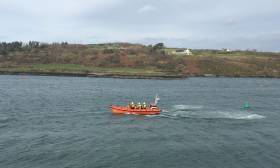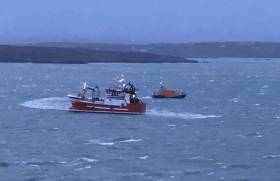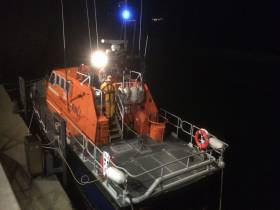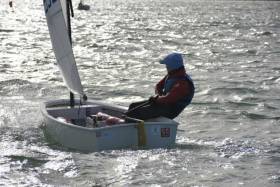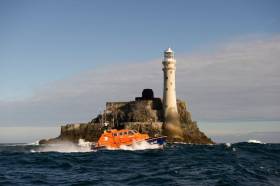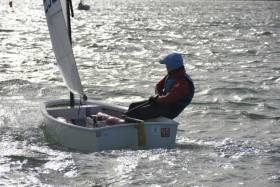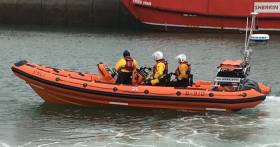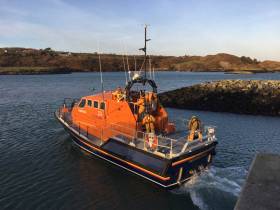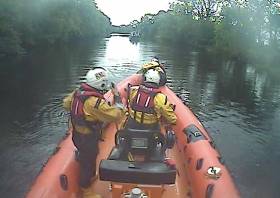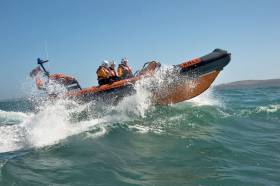Displaying items by tag: Baltimore
Baltimore Lifeboat Assists In Medevac From Heir Island
Baltimore RNLI carried out a medical evacuation last night (Wednesday 22 May) from Heir Island off the coast of West Cork.
Baltimore’s volunteer lifeboat crew launched their inshore lifeboat following a request from the Irish Coast Guard at 8.34pm to provide medical assistance and evacuation to a woman on Heir Island who had sustained injuries following a fall.
The inshore lifeboat arrived at the pier on Heir Island at 8.50pm and removed the casualty to the lifeboat station 20 minutes later, where she was handed over to the care of HSE Ambulance crew.
Conditions at sea during the callout were calm with good visibility and no sea swell.
This was the first call for Baltimore’s new Atlantic 85 inshore lifeboat, Rita Daphne Smyth, since she arrived on station last September.
Speaking following the callout, Baltimore RNLI volunteer lifeboat press officer Kate Callanan said: “Baltimore lifeboat is often called upon to safely transport casualties between the islands and mainland, and our volunteer crews are trained in casualty care.
“If you find yourself in need of medical assistance, call 999 or 112 and ask for the coastguard. We wish the casualty a full recovery.”
There were four volunteer crew onboard the lifeboat: helm Jerry Smith and crew members Kieran Collins, Micheal Cottrell and Ian Lynch. Assisting at the boathouse in Baltimore were Rianne Smith, Marty O’Driscoll and Kieran Cotter.
In other lifeboat news, the outgoing chair of Clonallen Bridge Club, Warrenpoint, Maire Murray, chose the RNLI as the charity of choice for the year 2018-19.
At a recent meeting of the Clonallen Bridge Club a cheque for £500 was handed over to John Fisher, Kilkeel RNLI lifeboat operations manager by the club’s incoming president Marius McQue.
Fisher said: “As a charity we are always very thankful for all the money collected and donated to the RNLI. Giving our lifesavers the equipment they need to save lives is very expensive so be assured that the funds raised are used in the best possible way.”
Baltimore & Portaferry Lifeboats Launch During Storm Hannah
Lifeboats in Baltimore and Portaferry were launched yesterday evening (Friday 26 April) as Storm Hannah swept over the island of Ireland.
Baltimore RNLI’s volunteer lifeboat crew launched their all-weather lifeboat at 8.30pm after learning of a local fishing trawler that was dragging its anchor in high winds near Sherkin Island in West Cork.
The lifeboat arrived on scene at 8.43pm and transferred four extra crew aboard the 26.2m trawler. Once they were satisfied that the casualty vessel was back at safe anchor, the lifeboat returned to station by 9.11pm as the storm intensified.
Conditions at sea during the callout were very rough, with Force 10 winds gusting to Force 11, and a two-metre sea swell within the harbour.
Elsewhere, the volunteer lifeboat crew from Portaferry RNLI launched to reports of a missing dingy with three people on board.
The lifeboat crew proceeded to Pig Island near Newtownards in Strangford Lough and were joined in the search by local coastguard and Rescue 119 from Preswick in Scotland.
However, all rescue teams were stood down after a thorough search of the area revealed nothing.
Commenting on the callout, Jordan Conway, Portaferry RNLI lifeboat press officer, said: “Despite the weather conditions deteriorating as the volunteer lifeboat crew reached the scene, a full search was carried out in conjunction with our colleagues in the coastguard and Rescue 119.”
As previously reported on Afloat.ie, Castletownbere RNLI also launched last night to a 33ft fishing vessel which lost all power in Bere Haven Harbour are the storm bore down.
While the severe weather has now passed, sea conditions will remain rough over the next few days, and Baltimore RNLI’s Kate Callanan urged anyone on or near the water to “exercise caution in particular along the coastline.
“If you get into trouble or see anyone in difficulty at sea or along the coast, call 999 or 112 and ask for the coastguard.”
Baltimore Lifeboat In Medical Evacuation From Sherkin Island
#Lifeboats - Baltimore RNLI carried out a medevac on Thursday night (11 April) from Sherkin Island off the coast of West Cork.
The volunteer crew launched their all-weather lifeboat following a request from the Irish Coast Guard at 9.29pm to provide medical assistance and evacuation to an islander living on Sherkin.
Conditions at sea during the callout were calm with good visibility and no sea swell.
The lifeboat arrived at Sherkin pier at 9.45pm, the casualty was brought onboard and the lifeboat departed the island within four minutes, handing the casualty over to the care of HSE ambulance crew at 10.08pm.
Speaking following the callout, Kate Callanan, Baltimore RNLI volunteer lifeboat press officer, said: “Baltimore RNLI regularly provides the vital service of medical evacuations (medevacs) for residents and visitors to local islands such as Sherkin, Cape Clear and Heir.
“If you find yourself in need of medical assistance, call 999 or 112 and ask for the coastguard.”
Elsewhere, volunteer lifeboat crews from the Aran Islands and Galway RNLI participated in a multi-agency training exercise on Galway Bay this week.
The all-weather lifeboat from Aran Islands RNLI and the inshore lifeboat from Galway Bay RNLI were among the many emergency service agencies that took part in a maritime mass rescue exercise.
The scenario training, which saw the lifeboat crew practise an evacuation of survivors from a seagoing ferry in a busy shipping lane, was organised as part of a multi-agency exercise co-ordinated by the Irish Coast Guard.
Among the other agencies involved were the Irish Coast Guard rescue helicopters located at Sligo and Shannon, Doolin/Inisheer Boat Unit, Costello Bay, Killaloe, Kilkee and Cleggan Coast Guard units, Galway Fire Service and the HSE.
Countdown to Baltimore Optimist Spring Training Week
#Optimist - Baltimore Sailing Club have started preparations for the annual invasion of Irish Optimist sailors for the week from next Sunday 17 February.
The International Optimist Dinghy Association of Ireland’s (IODAI) team of coaches are making plans for training both on and off the water.
Participating sailors are reminded to check and label all their equipment before packing for the week, especially if it has been put away all winter.
“We are looking forward to a great week of fun, action and friendships both on and off the water,” the IODAI said.
Meanwhile, registrations are now open for the 2019 Optimist Trials which will take place as part of the Irish Sailing Youth Nationals at the Royal Cork from 25-28 April.
Entry is by invitation only based on 2018 season results. Entries made before 10pm on Thursday 28 March will avail of the early bird rate of €120 (entry thereafter is €200) with the final date for entries no later than 10pm on Thursday 11 April.
Baltimore RNLI To Lay Wreath On Centenary Of Thomas Joseph Wreck
Next Wednesday evening (10 October), Baltimore RNLI's volunteer lifeboat crew will lay a wreath at the Catalogues to commemorate the centenary of the wreck of the Thomas Joseph.
The 60ft lugger was wrecked on the Catalogue Rocks between Sherkin Island and the mainland. Six people, including owner and captain John Daly, lost their lives in the tragedy, with five rescued.
The fishing boat had just been fitted with a new Parsons marine engine, but 100 years later it is still not known whether that was a contributing factor to the Thomas Joseph’s loss.
What is understood is that within 10 minutes of Baltimore on voyage to nearby Schull, disaster occurred.
Baltimore RNLI’s Facebook page has much more on the story HERE.
#Optimist - The International Optimist Dinghy Association Ireland (IODAI) is now recruiting both national and international coaches for its annual spring training week in Baltimore in February 2019.
Coaches must be available from Sunday 17 to Friday 22 February for what’s widely considered one of the top international sailing clinics for Optimist sailors.
Each year the West Cork event kicks off the Optimist season in Ireland, with some 100 young sailors taking part in the week-long clinic.
The IODAI advises that positions for instructors limited and will be allocated based on previous coaching experience working at the camp, availability, qualifications and the needs of the fleet from beginner level right up to international competitors.
Applicants should send their sailing CV by email by Friday 2 November at the latest to Mandy Kelly at [email protected]. Informal enquiries should be directed to the same address.
Baltimore RNLI Welcomes Inshore Lifeboat On Service
#Lifeboats - Baltimore RNLI has welcomed its new Atlantic 85 class inshore lifeboat on service in the West Cork village.
The inshore lifeboat arrived at Baltimore lifeboat station on Thursday 13 September and replaces the Atlantic 75 class lifeboat, Patricia Jennings, which has been used to save lives at sea in Baltimore since 2016.
Last week saw the volunteer lifeboat crew undertake familiarisation training on the Rita Daphne Smyth, and the new inshore lifeboat officially went on service at Baltimore lifeboat station last Thursday evening (20 September) alongside the all-weather lifeboat Alan Massey.
The new lifeboat has been funded through a legacy from the late Rita Daphne Smyth, a native of Harrow in Middlesex, England, who was a supporter of the charity’s volunteers in saving lives at sea.
The Rita Daphne Smyth will be officially named at a special
ceremony and service of dedication.
In her two years in Baltimore, Patricia Jennings launched 21 times, with its volunteer lifeboat crew rescuing 17 people.
The new lifeboat has some advancement on its predecessor. The Atlantic 85 is 10m longer than the Atlantic 75 and allows room for four crew members onboard rather than three.
The lifeboat is powered by two 115hp engines and has a stronger hull and greater top speed of 35 knots. The added radar allows the crew to operate more effectively in poor visibility and there is also VHF direction-finding equipment.
The vessel has a manually operated self-righting mechanism which, combined with inversion-proofed engines, keeps the lifeboat operational even after capsize. The lifeboat can also be beached in an emergency without causing damage to its engines or steering gear.
The Atlantic 85, which was introduced to the RNLI fleet in 2005, also carries a full suite of communication and electronic navigation aids, as well as a searchlight, night-vision equipment and flares for night-time operations.
Baltimore RNLI lifeboat operations manager Tom Bushe said: “We are extremely grateful to Miss Smyth for the generous legacy donation which has funded our new lifeboat.
“As we welcome a new lifeboat, there is also a sense of nostalgia among us today too as we bid a fond farewell to Patricia Jennings who provided us with two great years of service.
“Patricia Jennings time here in Baltimore brought many people safely to shore and we hope her donor family will be just as proud as we are, of her many achievements.
“We are looking forward to being the custodians of this new lifeboat which will allow our volunteers to go on to rescue and save many more lives in the years to come.”
Baltimore Lifeboat Called Out To Search For Missing Swimmer
#RNLI - Baltimore RNLI launched yesterday morning (Tuesday 11 September) to a swimmer reported missing on a swim from Skibbereen to Baltimore in West Cork.
The inshore lifeboat was called to search the Ilen River for the swimmer after a safety boat lost visual contact with him during a squall north of Inishbeg.
Within an hour they were joined by the all-weather lifeboat to search the narrower channels of the river. Toe Head Coast Guard and the Shannon-based Irish Coast Guard helicopter Rescue 115 also assisted.
Some 40 minutes later, at 11.10am, Mizen Head Coast Guard informed all rescue agencies that the swimmer had made his way safely to shore, and all were to stand down.
“This was a great example of multiple rescue agencies working together and thankfully ended with a good outcome,” said Baltimore RNLI press officer Kate Callanan.
Elsewhere in Cork, Ballycotton RNLI launched both their all-weather and inshore lifeboats on Friday afternoon (7 September) to a capsized small sailing dinghy off Ballynamona beach.
A concerned member of the public had witnessed the casualty having difficulty righting the capsized dinghy, which was some 400 metres from the beach.
The crew on board the inshore lifeboat located the casualty in the water approximately 80m from the scene attempting to swim ashore.
The male casualty, believed to have been in the water for nearly 30 minutes, was brought onboard the inshore lifeboat and transferred to the larger all-weather vessel where he was administered first aid, then brought ashore where a local doctor and ambulance crew were waiting to assist.
“Thanks to the vigilance and very quick thinking of the local members of the public, they contributed to a speedy recovery with a positive outcome for all involved,” said Ballycotton RNLI coxswain Eolan Walsh.
Busy Sunday For RNLI Lifeboats At Lough Derg, Baltimore & Portaferry
#RNLI - Lough Derg RNLI assisted four people after their boat ran aground when they took a wrong turn above Victoria Lock on the River Shannon yesterday (Sunday 9 September)
Water levels at the casualty vessel’s location were very low when the lifeboat arrived at 2.11pm, a little over an hour after launch.
All four on board the casualty boat were safe and unharmed. The skipper had dropped anchor as there was a strong flow, combined with wind, at the location.
While the vessel had sustained damage to its propellers and drive, its hull was not holed.
The lifeboat took the casualty vessel under tow back to the main navigation channel and onwards to Shamrock Marina at Banagher, the closest safe harbour and where the vessel had a mooring at which it was safely tied alongside at 4pm.
Peter Kennedy, deputy launching authority at Lough Derg Lifeboat Station, advises boat owners to carry up-to-date charts and to familiarise themselves with the buoyage on the Shannon.
Meanwhile, Baltimore RNLI launched their inshore lifeboat around 2.50pm to a sailing sloop that had filled with water near the West Cork harbour.
Within three minutes the inshore lifeboat reached the casualty boat, a 6m sailing vessel with two on board which had been caught up on pot buoys and knocked over by a strong gust.
Another RIB with a Baltimore lifeboat crew member was an ready on standby as the sailors bailed out their vessel, and after helping to speed up the process, they soon had the boat clear of water and ready to sail back to Baltimore Harbour unassisted.
Much earlier on Sunday, Portaferry RNLI were part of the multi-agency response to a Mayday call from a lone sailor on a 20m act grounded at Phennick Point near Ardglass in Co Down.
Due to the vessel’s position on dangerous rocks and with fishing gear in the area, only Portaferry’s inshore lifeboat was small enough to manoeuvre through the rocks and rough seas to retrieve the sailor and transfer him safety to Ardglass Marina.
Baltimore Lifeboat Launches To Speedboat With Engine Troubles
#RNLI - Baltimore RNLI was called out last night (Tuesday 4 September) to a speedboat with engine trouble near Bird Island in West Cork.
The volunteer lifeboat crew were on exercise in their inshore lifeboat when the request came in from the Irish Coast Guard at 7.55pm to assist the 17ft speedboat, with four people onboard and reporting to have engine trouble north of the island near Cape Clear.
The lifeboat, with three volunteer crew onboard — helm John Kearney, John McDonough and Colin Rochford — was already in the vicinity of Cape Clear when the call came in and reached the casualty vessel at 7.57pm.
Conditions at the time were calm with a northerly Force 2-3 wind and slight sea swell.
When the lifeboat crew arrived on scene, the speedboat was only 100m north of Bird Island and was drifting towards the shore in calm seas, but in an area known for its strong tides.
The lifeboat immediately secured a tow line to the bow of the speedboat and, after confirming all onboard were okay, they towed the vessel to Baltimore harbour.
In other news, Baltimore RNLI’s annual barbecue will be hosted by Derry and Sally Anne Clarke at Sherkin House on Sherkin Island from 1pm this Saturday 8 September. All are welcome and no booking is required.


























